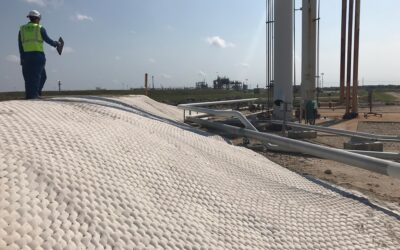Soil reinforcement and stabilization are important considerations for construction applications across a variety of industries, and geogrid is a valuable tool for improving soil-bearing capacity and stability.
But what is geogrid? Read on for a synthesis of what geogrid is, how it works, plus its benefits and applications.
Defining Geogrid
Geogrid is a geosynthetic material, a class of man-made materials used for soil reinforcement and other construction applications. There are several types of geosynthetic materials, each with different structures and specific purposes. Geogrids are flat, intersecting grids, generally made of polymers such as polyethylene, polypropylene, or polyester.
Geogrids can be created via the weaving of separate yarns or fibers, welding strips of geosynthetic material into grids, extrusion, or by punching a grid pattern into a solid sheet of geosynthetic material. The holes in geogrids are referred to as apertures, and the grid material as ribs or spines.
How Does Geogrid Work?
Geogrids increase soil stability by redistributing loads over greater areas and lending the soil into which they are installed their tensile strength. The geometric grid pattern and stiff but flexible material of the geogrid has good tensile strength and can resist stresses that soil — particularly nutrient-poor, eroded, or uncovered soil — does not. Soil settles into the apertures of the geogrid, strengthening the soil.
What is Geogrid Used For?
Geogrids are used in a variety of construction applications for soil stabilization, reinforcement, and erosion control. They are also used to increase resistance to seismic activity (i.e., earthquakes). Geogrids are used in industries such as
- Road construction
- Natural disaster recovery and reconstruction
- Environmental restoration
- Berm or levee construction
- Landfills
- Drilling and mining
- Energy transmission
- Water transport
- Wastewater treatment
Geogrids are commonly used for applications where the soil needs to withstand heavy loads, such as roadbeds, parking lots, or airport runways. Geogrids are also frequently used on steep slopes to prevent soil erosion and improve seismic stability.
What Are the Benefits of Using Geogrid?
The primary benefit of geogrid use for construction applications is reinforcing soil. But some of the benefits of using geogrids for this purpose, as opposed to other methods, include cost, increased speed of construction, and performance characteristics.
Geogrids can be less costly than other methods, especially since they work with a variety of fill soils and materials. They can also be installed quickly and to a shallower depth than other soil reinforcement methods, reducing costs and time to install by reducing the required depth of excavation.
Additionally, geogrids are highly resistant to damage from a variety of sources, including UV exposure, mechanical damage, and chemicals. They have a long life and resist creep and damage from enduring high loads.
Contact US FUSION for Expert Geogrid Installation
If geogrids sound like the right solution for your application — whether for slope stabilization and erosion control, increasing load-bearing capacity for heavy equipment roads on your construction site, or reinforcing soil for seismic resistance — US Fusion delivers. Our unique polypropylene geogrid offers excellent tensile strength and modulus for reinforcement and stabilization.
Reach out to learn more about how geogrid can work for your application.







